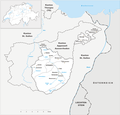Arnold Rothstein: Difference between revisions
CSV import |
CSV import |
||
| Line 1: | Line 1: | ||
{{short description|Canton of Switzerland}} | |||
{{Use dmy dates|date=October 2023}} | |||
'''Appenzell Innerrhoden''' is the smallest canton of [[Switzerland]] by population and the second smallest by area. It is located in the northeastern part of the country and is known for its traditional Swiss culture and picturesque landscapes. | |||
== | ==Geography== | ||
Appenzell Innerrhoden is situated in the [[Alps]] and is characterized by rolling hills and lush green pastures. The canton is bordered by the canton of [[Appenzell Ausserrhoden]] to the north and west, and the canton of [[St. Gallen]] to the east and south. The capital of the canton is the town of [[Appenzell]]. | |||
[[File:Karte Kanton Appenzell Innerrhoden 2010.png|thumb|Map of Appenzell Innerrhoden]] | |||
== | ==History== | ||
The history of Appenzell Innerrhoden is closely linked with that of its neighbor, Appenzell Ausserrhoden. The region was originally part of the [[Abbey of Saint Gall]]'s territory. In the late Middle Ages, the people of Appenzell fought for and gained independence from the abbey. The canton was officially split into Appenzell Innerrhoden and Appenzell Ausserrhoden in 1597 due to religious differences during the [[Reformation]]. | |||
[[File:Schilling Schlacht bei Voeglinsegg 1403.jpg|thumb|Battle of Vögelinsegg, 1403]] | |||
== | ==Politics== | ||
Appenzell Innerrhoden is unique in Switzerland for its traditional form of direct democracy. The canton holds an annual [[Landsgemeinde]], an open-air assembly where citizens gather to vote on laws and elect officials by a show of hands. This event takes place in the town of Appenzell and is a significant cultural tradition. | |||
[[ | [[File:Appenzeller Landsgemeinde.jpg|thumb|Appenzeller Landsgemeinde]] | ||
[[ | |||
[[ | The canton is governed by a seven-member executive council known as the [[Standeskommission]]. The legislative authority is the [[Grosser Rat]], which consists of 50 members. | ||
[[Category: | |||
[[Category: | [[File:Regierung Appenzell Innerrhoden 2010.JPG|thumb|Government of Appenzell Innerrhoden]] | ||
==Economy== | |||
The economy of Appenzell Innerrhoden is primarily based on agriculture, particularly dairy farming and cheese production. The canton is famous for its [[Appenzeller cheese]], which is known for its strong flavor. Tourism also plays a significant role in the local economy, with visitors attracted to the region's natural beauty and cultural heritage. | |||
==Culture== | |||
Appenzell Innerrhoden is renowned for its rich cultural traditions, including music, dance, and festivals. The canton is known for its traditional costumes, which are often worn during festivals and celebrations. The local dialect, a variant of [[Swiss German]], is widely spoken. | |||
==Municipalities== | |||
Appenzell Innerrhoden is divided into six districts, which function as municipalities. These are: | |||
* Appenzell | |||
* Schwende | |||
* Rüte | |||
* Gonten | |||
* Oberegg | |||
* Haslen | |||
[[File:Karte Gemeinde Appenzell 2022.png|thumb|Map of the municipality of Appenzell]] | |||
==Related pages== | |||
* [[Appenzell Ausserrhoden]] | |||
* [[Swiss cantons]] | |||
* [[Landsgemeinde]] | |||
==Gallery== | |||
<gallery> | |||
File:Karte Kanton Appenzell Innerrhoden 2010.png|Map of Appenzell Innerrhoden | |||
File:Schilling Schlacht bei Voeglinsegg 1403.jpg|Battle of Vögelinsegg, 1403 | |||
File:Karte Gemeinde Appenzell 2022.png|Map of the municipality of Appenzell | |||
File:Regierung Appenzell Innerrhoden 2010.JPG|Government of Appenzell Innerrhoden | |||
File:Appenzeller Landsgemeinde.jpg|Appenzeller Landsgemeinde | |||
</gallery> | |||
[[Category:Cantons of Switzerland]] | |||
[[Category:Appenzell Innerrhoden]] | |||
Revision as of 17:54, 11 February 2025
Canton of Switzerland
Appenzell Innerrhoden is the smallest canton of Switzerland by population and the second smallest by area. It is located in the northeastern part of the country and is known for its traditional Swiss culture and picturesque landscapes.
Geography
Appenzell Innerrhoden is situated in the Alps and is characterized by rolling hills and lush green pastures. The canton is bordered by the canton of Appenzell Ausserrhoden to the north and west, and the canton of St. Gallen to the east and south. The capital of the canton is the town of Appenzell.

History
The history of Appenzell Innerrhoden is closely linked with that of its neighbor, Appenzell Ausserrhoden. The region was originally part of the Abbey of Saint Gall's territory. In the late Middle Ages, the people of Appenzell fought for and gained independence from the abbey. The canton was officially split into Appenzell Innerrhoden and Appenzell Ausserrhoden in 1597 due to religious differences during the Reformation.

Politics
Appenzell Innerrhoden is unique in Switzerland for its traditional form of direct democracy. The canton holds an annual Landsgemeinde, an open-air assembly where citizens gather to vote on laws and elect officials by a show of hands. This event takes place in the town of Appenzell and is a significant cultural tradition.

The canton is governed by a seven-member executive council known as the Standeskommission. The legislative authority is the Grosser Rat, which consists of 50 members.

Economy
The economy of Appenzell Innerrhoden is primarily based on agriculture, particularly dairy farming and cheese production. The canton is famous for its Appenzeller cheese, which is known for its strong flavor. Tourism also plays a significant role in the local economy, with visitors attracted to the region's natural beauty and cultural heritage.
Culture
Appenzell Innerrhoden is renowned for its rich cultural traditions, including music, dance, and festivals. The canton is known for its traditional costumes, which are often worn during festivals and celebrations. The local dialect, a variant of Swiss German, is widely spoken.
Municipalities
Appenzell Innerrhoden is divided into six districts, which function as municipalities. These are:
- Appenzell
- Schwende
- Rüte
- Gonten
- Oberegg
- Haslen

Related pages
Gallery
-
Map of Appenzell Innerrhoden
-
Battle of Vögelinsegg, 1403
-
Map of the municipality of Appenzell
-
Government of Appenzell Innerrhoden
-
Appenzeller Landsgemeinde




